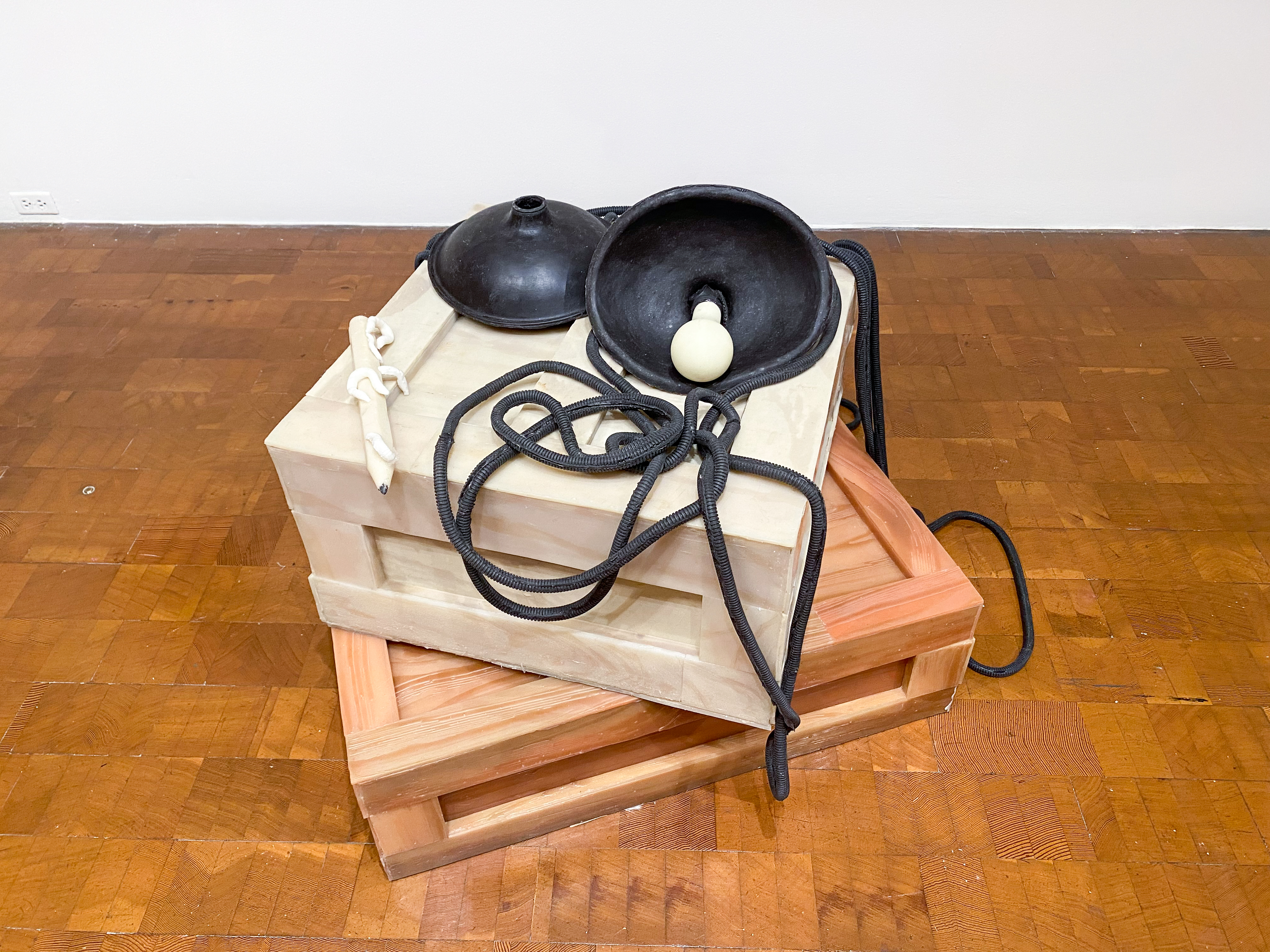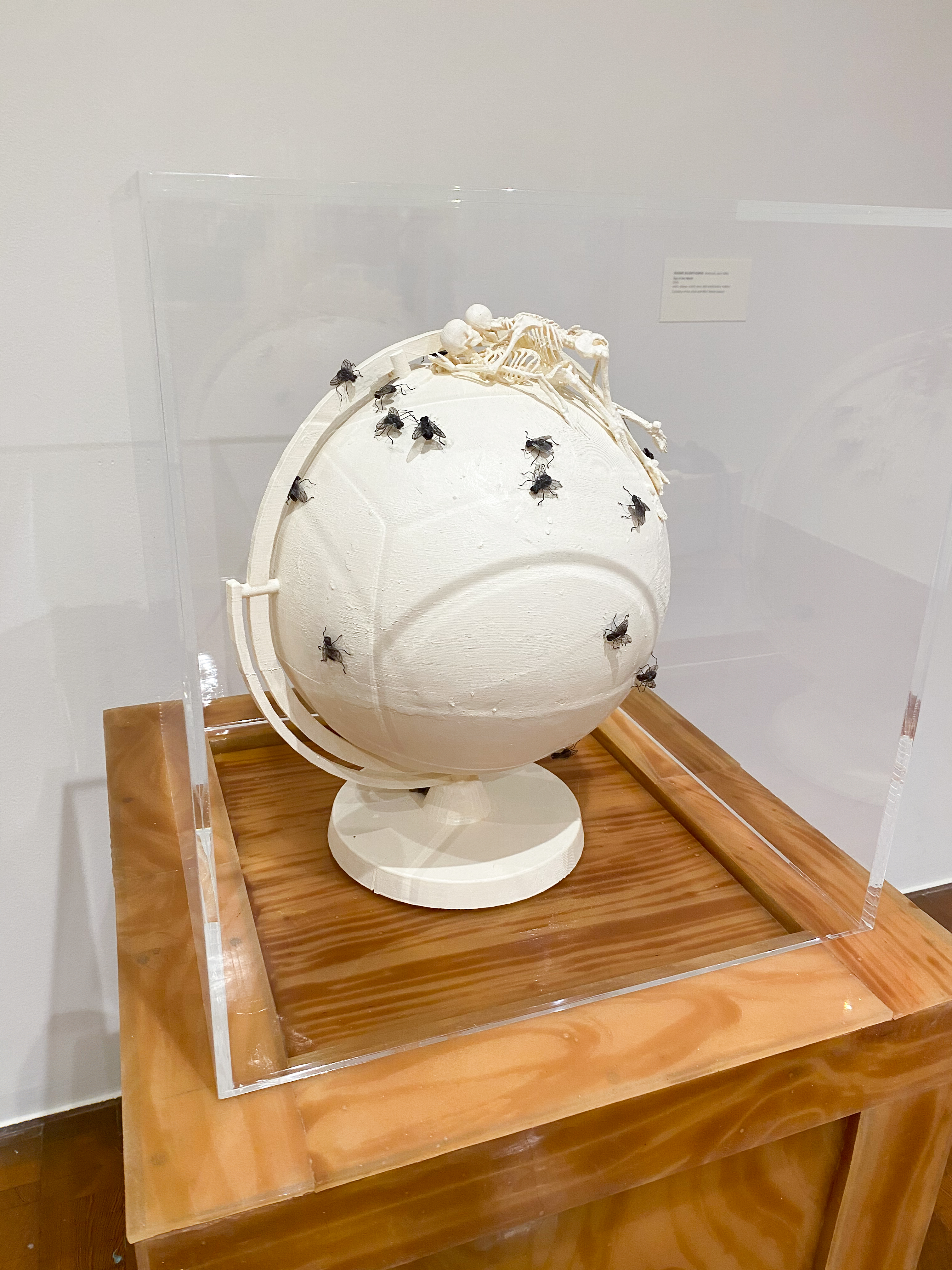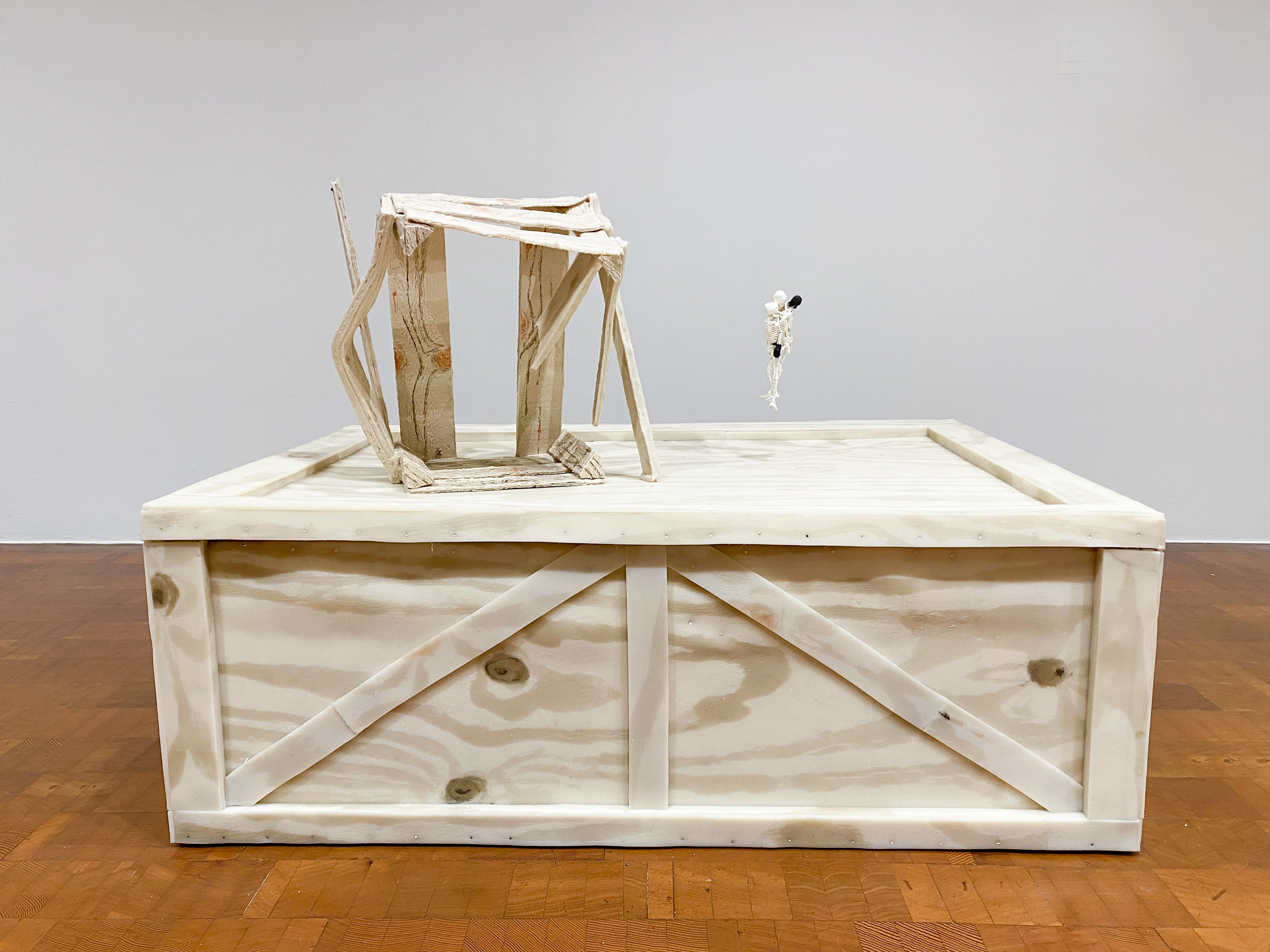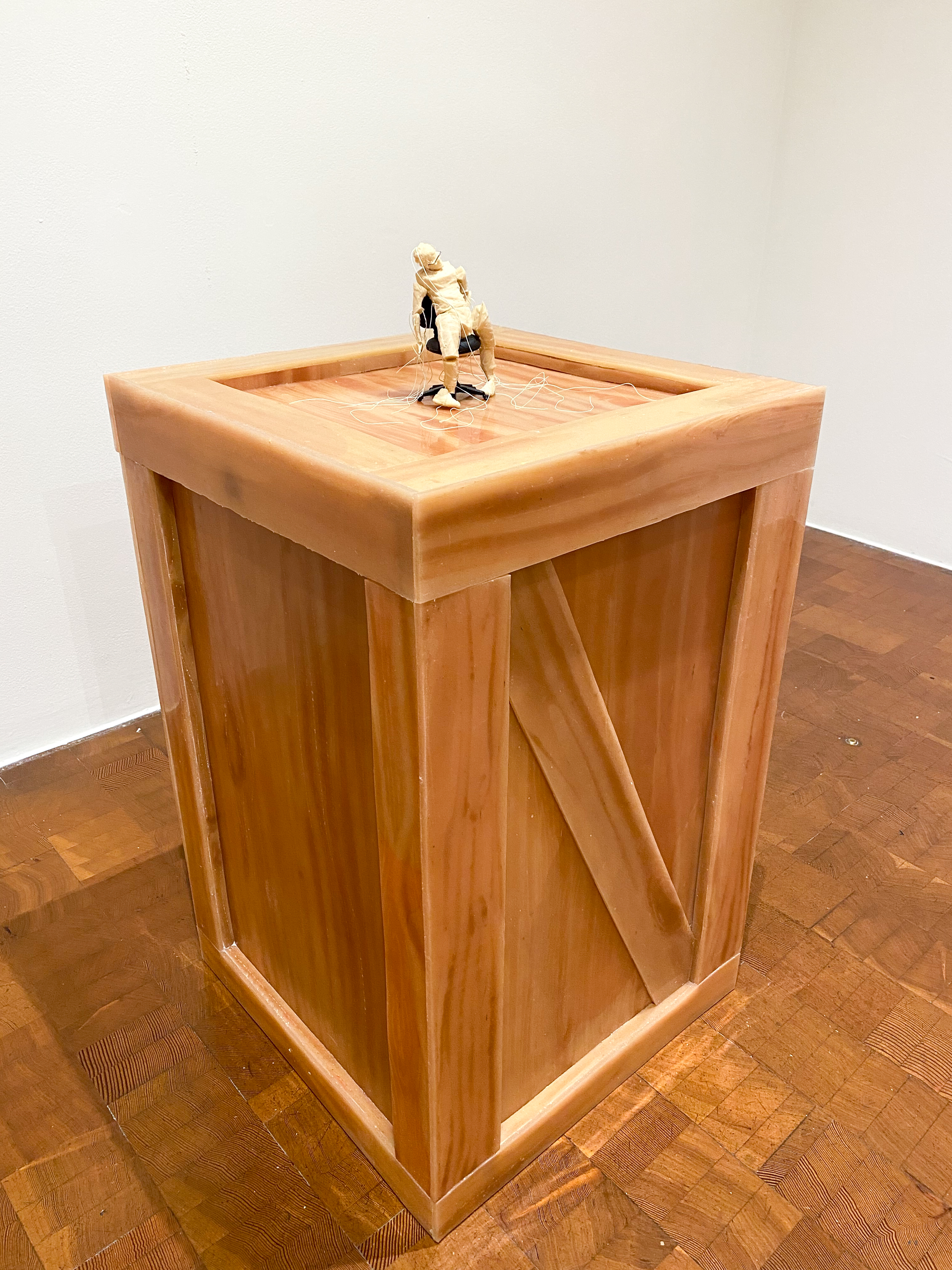

Above: install of More Flesh and Bone.
Jeanne Silverthorne: More Flesh and Bone
Review
Mary Clore
More Flesh and Bone, Jeanne Silverthorne’s solo exhibition at the University of Kentucky Art Museum, is an exercise in fragility, temporality, and artifice. Death is omnipresent in this cohesive body of sculpture, but there is too much satisfaction in the minute details of her work to leave the viewer completely desolate. Silverthorne supplements morbidity with explorations of the paradoxical things which make us human: the co-mingling of love and fear, the transience of pleasure, and the ability to create in the face of destruction.
The subjects of Silverthorne’s sculptures are overt memento mori—skeletons, flies, maggots, and lightbulbs all remind the viewer of life’s impermanence. Crates with Fallen Lights and Svevo’s Pencil (2014) features semi-convincing rubber replicas of the objects listed in the title. The pencil, designated to Italian author Italo Svevo, is crawling with white maggots. Amidst these emblems of death, Silverthorne summons an author whose most famous novel states, “...unlike other sicknesses, life is always fatal. It doesn't tolerate therapies. It would be like stopping the holes that we have in our bodies, believing them wounds. We would die of strangulation the moment we were treated.”1 Silverthorne’s use of rubber introduces similar paradoxes to her sculptures. The slight sag of the reflector around the dull rubber lightbulb indicates that the material is soft like flesh but, unlike the organic material of the body, rubber has a synthetic longevity. At the same time, it lacks the structural integrity of traditional sculpture materials like wood and stone. It may have elasticity now, but it will harden, crack, and discolor over time. Like the too-smooth surface of the rubber crates, the material exists in a slippery space between the fixed and the ephemeral.
More symbols of death appear in Top of the World (2014). Two delicate, skeletal figures lie entangled in each other’s arms on top of a rotating white globe scattered with life-size black flies. Silverthorne simplifies activity on earth into two categories: pleasure and decay. The viewer can draw a line from one to the other: pleasure before inevitable decay, or pleasure in spite of it. The endless spin of the globe and presence of carrion-feeding flies, however grim, suggest a cycle in which one day is followed by another, decay is followed by regrowth, and tiny acts of joy and intimacy are perhaps the only things worthwhile. What else are we to do during our limited number of rotations? That brings us back to Svevo’s aforementioned novel, Zeno’s Conscience, in which the protagonist quits smoking again and again throughout his lifetime because he has discovered that the last cigarette before quitting is better than any other cigarette. Isn’t their eventual end what makes moments of joy sweeter and more meaningful?
In Silverthorne’s more narrative imagery, she positions human fragility and cynicism as obstructions to the pleasure we seek. The figures in Crates and Skeletons (2019) hang suspended in an embrace like a slow dance, though each wears a pair of boxing gloves. In contrast to the frailty of miniature bones, the boxing gloves give the figures’ affectionate pose an undertone of violent potential. Silverthorne introduces power and dependence into the human need for connection—not just a physical need, but an economic and existential one too. In Unstrung (Puppet Me) (2014), the artist appears as a silicone rubber puppet sitting in a swivel chair just a few inches tall. The puppet’s strings are cut, and its limp posture denotes exhaustion from performing for an audience, or inertia in the absence of a controlling hand. Artistic creation exists in an ecosystem rather than a vacuum, beholden to the whims of curators, critics, buyers, or a faceless audience. Severed ties are central to Silverthorne’s vision of an artistic career’s demise.
Silverthorne’s work is not entirely nihilistic. There are traces of humor, and her use of miniature scale offers the viewer a certain gratification; like scenes in a dollhouse, there is pleasure in zooming out on our inadequacies and limitations. During a period of time defined by pestilence, death, and climate collapse, however, Silverthorne’s memento mori seem redundant. “Remember that you must die''—who can forget? The more helpful reminder, as told by tiny skeletons and drooping light bulbs, is what sustains us in this life: connection, creativity, and whatever amount of joy one can muster in our impermanent state.
-
More Flesh and Bone is on view at the University of Kentucky Art Museum through February 13, 2021.
The University of Kentucky Art Museum is located in the Singletary Center for the Arts at 405 Rose Street, Lexington, KY 40506, and is open Tuesday through Friday 10am-5pm and Saturdays 12-5pm. At the time of this publication, the Museum requires reservations for visitors.
-
Notes:
- 1. Italo Svevo, Zeno’s Conscience, trans. William Weaver (New York: Random House, 2001), 437.
- https://finearts.uky.edu/art-museum
- http://www.jeannesilverthorne.org/
-
12.22.20
Mary (she/her) is a painter and printmaker. She has a BFA and a BA in Art History from the University of Louisville, and has been working in art museums since the age of 15. Mary is a founding member of Ruckus and contributing writer.

Crates with Fallen Lights and Svevo’s Pencil (2014), rubber and phosphorescent pigment.

Top of the World (2014), resin, rubber, wood, wire, and motorized turntable.

Crates with Skeletons (2019), platinum silicone rubber, wood, and paint.

Unstrung (Puppet Me) (2014), platinum silicone rubber, phosphorescent pigment, wire, resin, hair, and thread.







